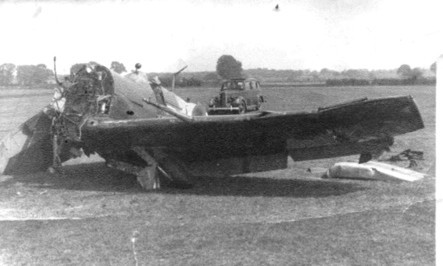A poignant chapter has been written to bookend the history of Arbroath’s renowned Red Lichtie Spitfire.
Funded by the people of the town in the Second World War, the iconic aircraft was celebrated in 2012 with a programme marking 70 years since it took to the skies at the start of a distinguished RAF service career.
Many associations with the Merlin-engined aircraft EP121 have emerged before and since the anniversary event, but enthusiasts behind the Arbroath Spitfire website have now been stunned by out-of-the-blue contact from a man whose father survived the crash which consigned the Red Lichtie to the scrap heap in the summer of 1943.
Canadian pilot, Sergeant William Hewitt Palmer was at the controls of the Red Lichtie on its approach to the No. 416 Squadron base at Digby in Lincolnshire when the engine stalled and the Spitfire smashed into the ground.
The strength of the cockpit probably saved Sgt Palmer’s life but the aircraft was written off.
The pilot’s place in the story of the Red Lichtie was already known, but Mr Palmer’s son, Alan, has now made contact with Gill Howie of Arbroath firm Squadron Prints to put a very significant piece into the jigsaw.
Gill’s company produced a print of the Red Lichtie as part of the 70th anniversary celebrations and the extensive research into the aircraft was collated in the website, www.thearbroathspitfire.com.
“Perhaps the greatest excitement was when I managed to contact a surviving Spitfire pilot who had actually flown the Red Lichtie, but sadly no more photos apart from two well-known pictures were found,” she said.
The surprise contact from Canada has now produced a treasure trove of photographs and documents of Sgt Palmer’s time in the Red Lichtie crew.
Alan Palmer described the website as a “revelation” but said he was disappointed not to have known about it in time for the 2012 celebration.
“After the accident my father spent several weeks recovering at hospitals in Linconshire and it wasn’t until November that year that he returned to Spitfire ops,” he told Gill.
“He went on to take part in the invasion of Normandy and flew fighter cover over the beaches on June 6, and by the end of his tour had shot down three enemy aircraft.”
After the war and his return to Canada, Sgt Palmer was killed in a flying accident in July 1968. Both Mr Palmer Jr and his brother, Bob, also learned to fly and both joined Canadian Pacific Airlines.
“I completed my career in 2004 on Boeing 747-400s and Bob on Boeing 737s in 2008. Dad would have been proud,” said Mr Palmer.
The family still have Sgt Palmer’s original logbook, with photographs of the wrecked Red Lichtie pasted into it. Gill said she was moved to tears by the poignant postscript to the Red Lichtie story.
“After making contact with Alan, more and more material kept popping into the email box, a very touching and personal story,” she said.
